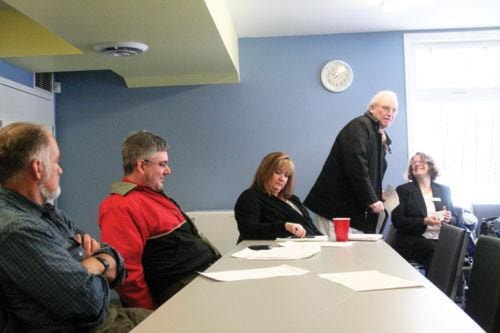A small group of local employers turned up at the last week to find out more information about programs available to them to help deal with the economic aftermath of the Babine Forest Products explosion and fire on Jan. 20, 2012.
Since then, more than 200 applications for have been submitted from the �������� Lake area.
Andrew Seabrook, program officer for in Prince George, Diane Beaulieu, program officer from the Ministry of Social Development employment and labour market services division and Shirley Kimery, director of Service Canada, Kamloops gave a presentation on the job share program and explained how it could benefit local employers that are experiencing an economic slow down, as well as their employees.
"We are here to make sure employers know about the program. It has been available for many years and because of this it is sometimes forgotten," Kimery said.
According to Seabrook, the work share program is an adjustment program designed to help employers and employees avoid temporary layoffs when there is a reduction in the normal level of business activity that is beyond the control of the employer.
Kimery said that the program not only helps employers retain their skilled employees during unexpected tough economic times, but it also helps employees maintain their skills and keep their job by supplementing their wages with Employment Insurance benefits for the days they are not working.
She said a job sharing arrangement has to be agreed upon by both the employer and employee as well as Service Canada.”
Kimery said employers are not able to use the job share program to help cope with seasonally adjusted work. "For example, if you are in the tourism industry and every winter you know it slows down, you need to adjust your business plan accordingly and you can't use the work share program in this instance."
To be eligible to participate in a work share program employers must have been in year round business in Canada for at least two years, demonstrate a recent decrease in business activity of approximately 10 per cent, demonstrate that the work shortage at their business is temporary and beyond their control and submit and implement a recovery plan designed to return the work sharing program to normal working hours by the end of the work sharing agreement. "I know it is a lot of paper work but it is a really worthwhile program," Kimery said.
The initial duration of a work sharing agreement must be between a minimum of six consecutive weeks and a maximum of 26 consecutive weeks.
Employers may also request an extension of up to 12 weeks.
Employee eligibility is also a factor. Kimery said the employee has to be a core staff member, meaning they have to be a permanent full time or part time employee who carries out the day to day functions of the business.
The employee must also be eligible to receive regular Employment Insurance benefits and agree to a reduction of their normal working hours, in order to share the available work with other employees.
If the employer is still challenged economically after the work share program ends and has to lay off employees, the employees are entitled to their regular Employment Insurance benefits.
A local employer asked if the work share program could be applied to just one employee or does it have to be all employees at the business?
"All core employees need to be included. If you are using work share for one electrician, you have to have all electricians at the business on work share. If it is a building crew member, then it had to be all the building crew."
Greg Brown, manager asked if a business has 10 employees and has to lay half off after the work share program has ended, would there be a waiting period for the regular Employment Insurance benefits?
"Yes. The employees would be entitled to regular Employment Insurance, but at that point they would have to serve the regular two week waiting period," Kimery added.
For more information on the work share program go to www.servicecanada.gc.ca.



